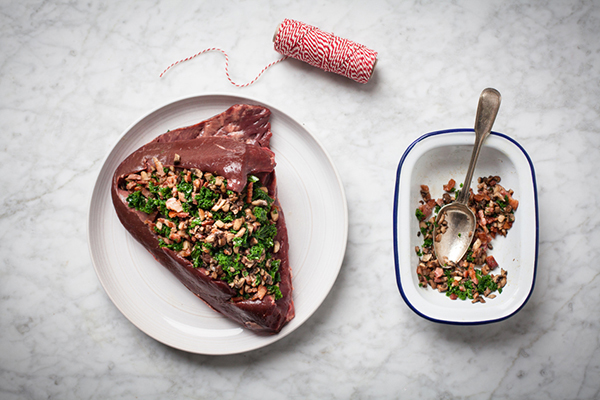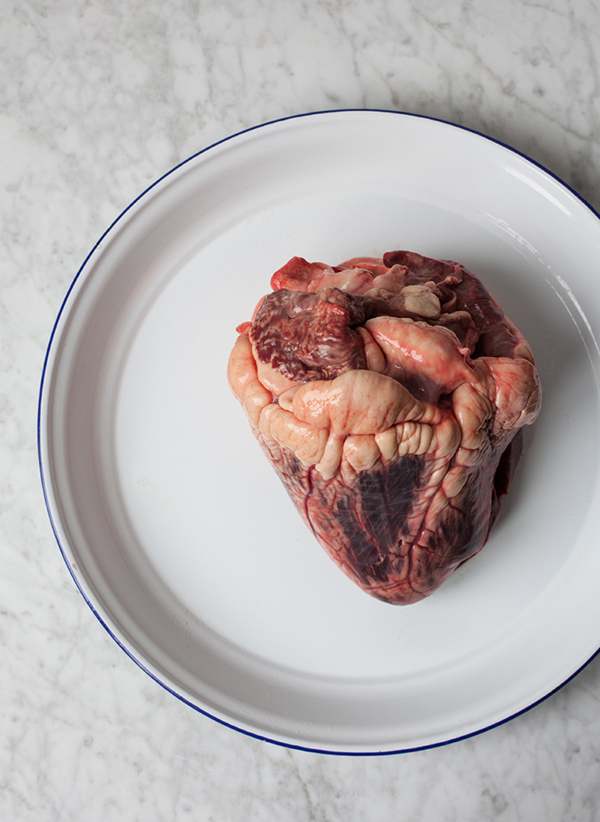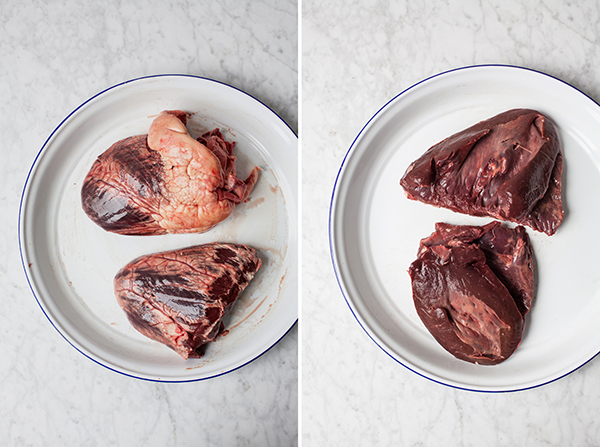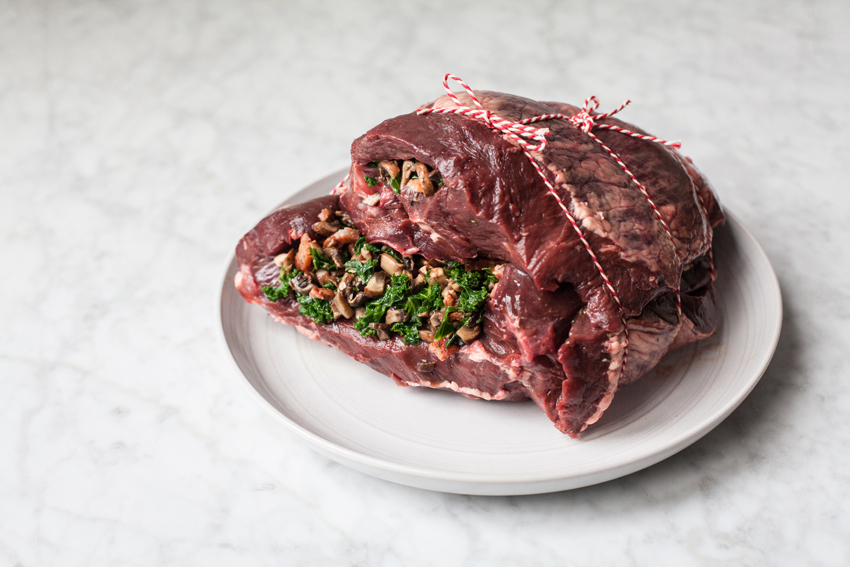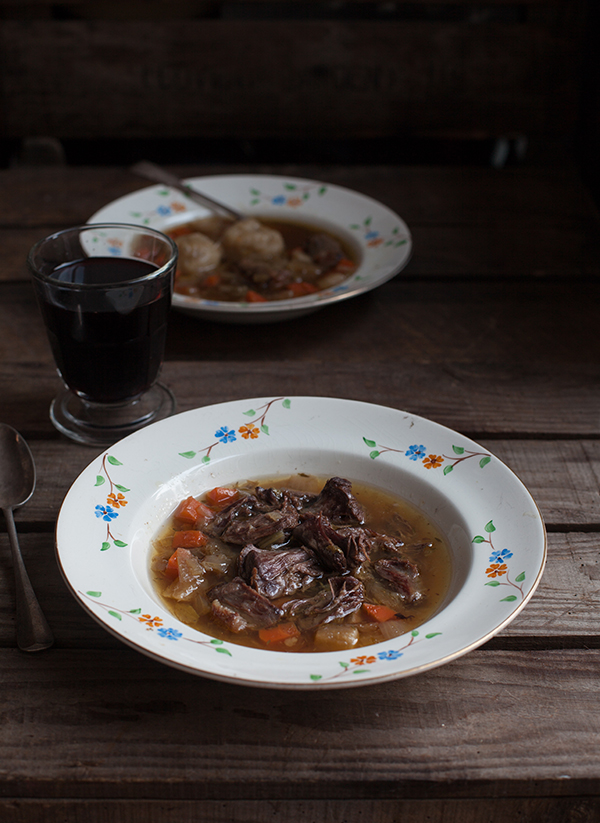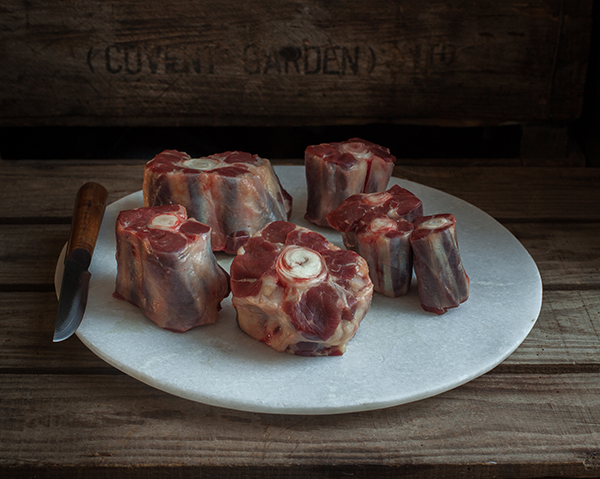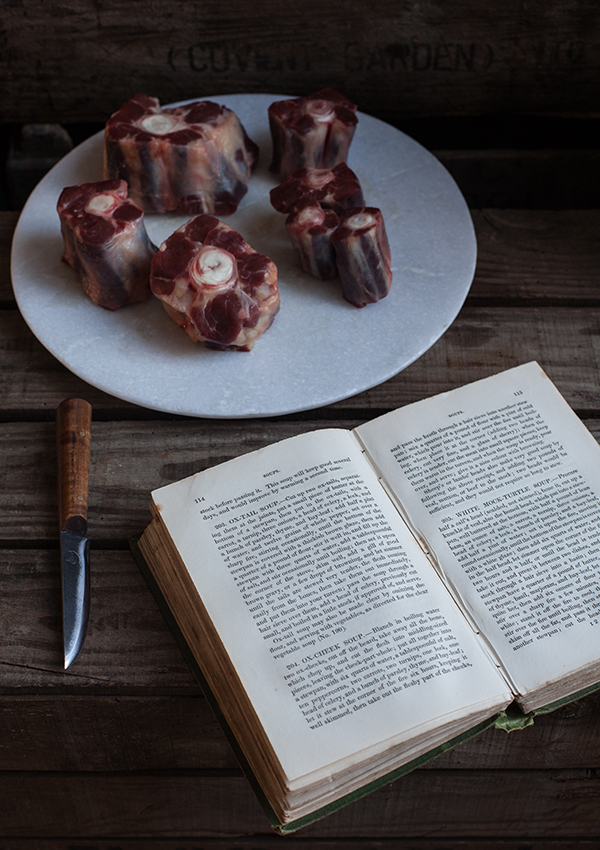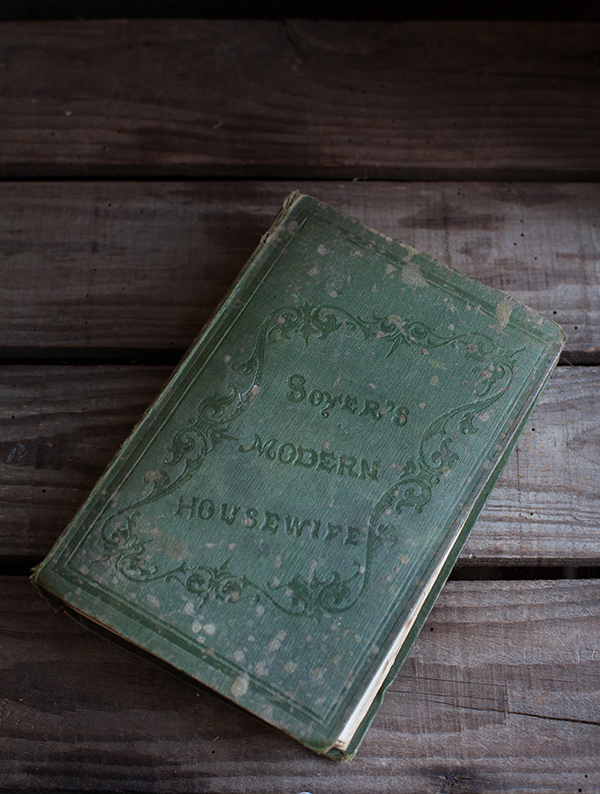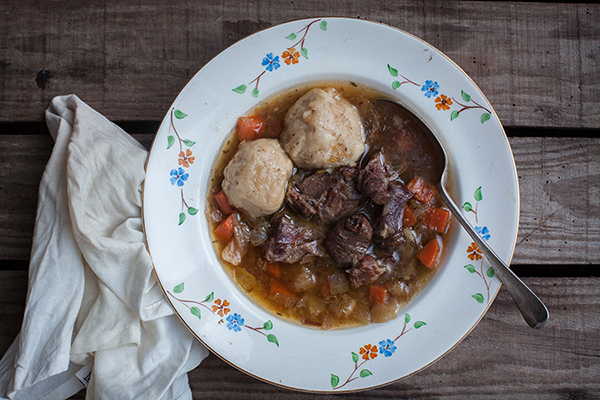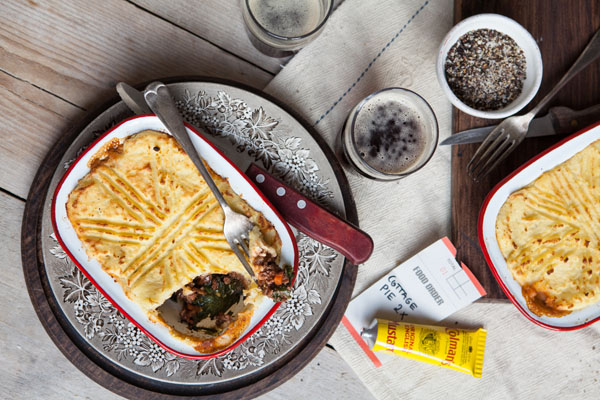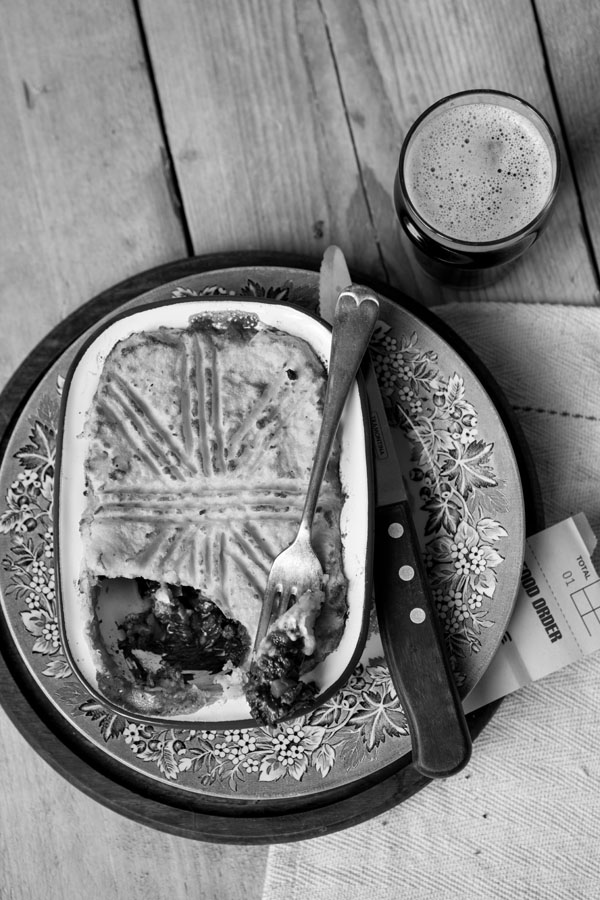The post Ox heart stuffed with kale, bacon and mushrooms appeared first on Miss Foodwise.
]]>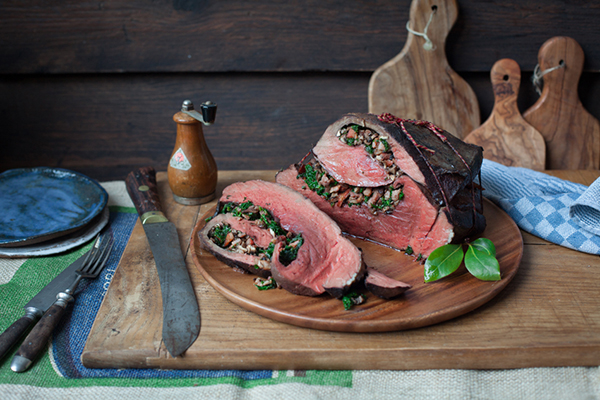 The meat of the heart is eaten quite commonly in Peru, but it might surprise some of you that for centuries is was also eaten in England. Beef heart is so unpopular I get mine from a local farm for as little as £3. That is great value for a huge piece of meat. I asked a couple of butchers, some in Belgium and also Borough Market. Beef heart is the kind of cut that doesn’t get sold and that is such a shame.
The meat of the heart is eaten quite commonly in Peru, but it might surprise some of you that for centuries is was also eaten in England. Beef heart is so unpopular I get mine from a local farm for as little as £3. That is great value for a huge piece of meat. I asked a couple of butchers, some in Belgium and also Borough Market. Beef heart is the kind of cut that doesn’t get sold and that is such a shame.
The flavour and texture of beef heart is like that of a good beefy steak because beef heart is a muscle just like steak is. I find beef heart great in any way it is cooked because it has so much flavour and it is very tender. In Peru they make kebab style roasted beef heart, in England beef heart was usually stuffed with a forcemeat.
A couple of years ago I found a recipe for a stuffed beef heart in Elizabeth Raffald’s book The Experienced English Housekeeper (1769):
Wash a large beast’s heart clean and cut off the deaf ears, and stuff it with forcemeat as you do a hare, lay a caul of veal, or a paper over the top, to keep in the stuffing, roast it either in a cradle spit or hanging one, it will take an hour and a half before a good fire; baste it with red wine; when roasted take the wine out of the dripping pan and skim off the fat, and add a glass more of wine; when it is hot put in some lumps of red currant-jelly and pour it in the dish; serve it up and send in red currant-jelly cut in slices on a saucer.
The recipe was copied later by M. Radcliffe in her A Modern System of Domestic Cookery: Or, The Housekeeper’s Guide (1823) and it was also published in a later edition of Hannah Glasse’s The Art of Cookery made Plain and Easy – A new Edition (1803). The recipe dit not appear in the first edition of 1747. Copying recipes from other cooks was common practice in those days and they were often copied word for word, making it easy to determine their source.
To make this dish slightly lighter I opted to stuff the heart with a duxelles, which is a mixture made with mushrooms, bacon and in this case kale or cavolo nero. If I had caul – a thin lace-like membrane which surrounds the stomach internal organs of some animals – like Raffald suggested, I would have used it as it keeps in the stuffing in nicely and tidy. But if you can not obtain it, some creative string-work will do the trick just fine.
The heart should be a deep brownish red with a large amount of yellow fat on the top. The fat looks a lot like kidney fat – which is suet – though it can not be used as such and is best just discarded. Ask your butcher to trim it for you if you aren’t up to the task, but there really is nothing to be afraid of here and it is actually quite humbling to make use of a heart. It is a beautiful cut of meat and flavourwise it is spot on if you want your dish to have a strong beef flavour. It is not bloody, and it does not have a particular scent. It was very interesting too, to see the blood vessels and such but I must admit I do like to trim meat as I find it a very gratifying job.
Why not try it for your next sunday roast? Leftovers can be pan fried the next day and tucked into a warm pita bread or tossed over a nice salad with either winter greens or summery ones depending on your current climate. In either case try it with a mayonnaise made with lots of chives added to it and blended.
- 1 large beef heart (mine was 5kg – untrimmed)
- 180 g bacon
- 250 g chestnut mushrooms
- 1 handful of cavolo nero or curly kale, blanched
Method
Preparing the heart
- Your butcher might have halved it and removed parts already but usually the heart comes with muscle fat, arteries and blood vessels. This isn’t something to be scared of, it is actually quite beautiful to see what a heart looks like.
- Let’s get started. Remove the hard fat, no worries if you cut away a little of the meat, it is safer to do this then to cut into the fat which is tough. Then trim away the two flaps on the top, these used to be known as ‘deaf ears’ and you’ll see why as they look a little like pigs ears. On the outside of the heart you will notice some large arteries and blood vessels, just cut these out.
- On the inside, remove the stringy parts.
- If the heart still has a piece which looks a bit like an air pipe, remove this also until you end up with two parts of heart without any hard bits left.
- No need to completely remove the fat, a little left will be fine and it will give flavour.
Now make the duxelles filling
- Boil salted water in a kettle and blanch the kale, then refresh under cold water so the colour remains fresh and beautiful.
- Fry your bacon until crisp, I like to use 1/2 cm pieces, and remove from the pan.
- While your bacon is frying, cut your mushrooms into small 1/2 cm cubes, roughly, we will not measure it. Now fry the mushrooms in the bacon fat, adding butter if needed, but do not let them get too much colour. Normally we would season now, but as the bacon can be very salty we will do this once we mix everything together.
- Chop up your fried bacon into smaller pieces so they are not too much larger then the mushrooms.
- Now chop up your kale until the pieces are of a size which is great to mix in with the bacon and mushrooms.
- Mix everything together and season with pepper. I don’t think you will need salt, but judge for yourself.
- Let this cool.
- Place one part of the heart on a plate, if your smart, already place butcher’s twine under the heart so you don’t need to pick it up when the filling has gone in.
- Spoon the filling on the heart, then place the other half of the heart on top and tie it with the twine.
Preheat your oven to 150° C
- Get a large cast-iron skillet scorching hot, put a generous knob of butter into the pan and a splash of vegetable oil. Carefully place the heart into the pan and fry it about 3 minutes on each side, being very gentle when turning it over.
- When fried on each side place on top of a wire-rack into a baking dish and transfer to the bottom part of your oven.
- Roast for 40 minutes if you like it medium rare as I have, longer if you like it more done. But don’t let it roast for too long as the meat does need to be pink.
Serve with all the trimmings you would serve for a sunday roast.
A slightly different version of this recipe also appeared on Great British Chefs as I was asked to develop a couple of recipes with unusual beef cuts.
You might also enjoy:
Soyer’s Oxtail soup with suet dumplings >
The post Ox heart stuffed with kale, bacon and mushrooms appeared first on Miss Foodwise.
]]>The post Alexis Soyer’s Oxtail Soup with simple suet dumplings appeared first on Miss Foodwise.
]]>19th century Victorian England saw a rapid growth of population and urbanisation stimulated by the Industrial Revolution. The elite became more wealthy and the poor became poorer. Eliza Acton noted in her book published in 1845, that soups or pottage was hardly eaten by the English. The poor didn’t have means to heat up the dish that had sustained them for centuries, and often they didn’t even have access to the ingredients to make a soup. This was an era of slum housing, starvation and disease.
Of course the old lady was illiterate and Soyer realising that he might have sent a useless bit of paper to her, went to see her and found ‘six elderly matrons and an old man holding council together’, trying to make out Soyer’s writings. He then read the recipes to them.
Of soup he says that he finds it is no wonder that people have abandoned this dish as the recipes in most cookery books are complicated and expensive. Many contemporary cookery writers like Mrs Beeton made notes on how to cook economically but showed their ignorance by not grasping the fact that most lower class families were lucky to have some kind of roof over their heads, so a kitchen or fire would most probably been a luxury they could only dream of.
To make this into a main dish for your supper, you can add dumplings, I give you here the recipes as adapted from Soyer’s book The Modern Housewife or Menagerie.
Oxtail soup with dumplings
- 1 oxtail
- 1 carrot
- 1 turnip
- 3 medium sized onions
- 1 stalk of celery
- 2 bay leaf
- a few sprigs of thyme
- a few sprigs of parsley
- 600ml water
- 1tsp of peppercorns, or about 15 corns
- 1tsp salt
- 1 carrot
- 1 stalk of celery
- 1 leek
- 1 turnip
- 220 g plain white flour
- 110 g shredded suet
- 0,5 tsp salt, the same of pepper
- 150-180 ml water
- optional: a tsp of thyme leaves or parsley cut finely
The post Alexis Soyer’s Oxtail Soup with simple suet dumplings appeared first on Miss Foodwise.
]]>The post George, the Dragon and the Cottage pie appeared first on Miss Foodwise.
]]>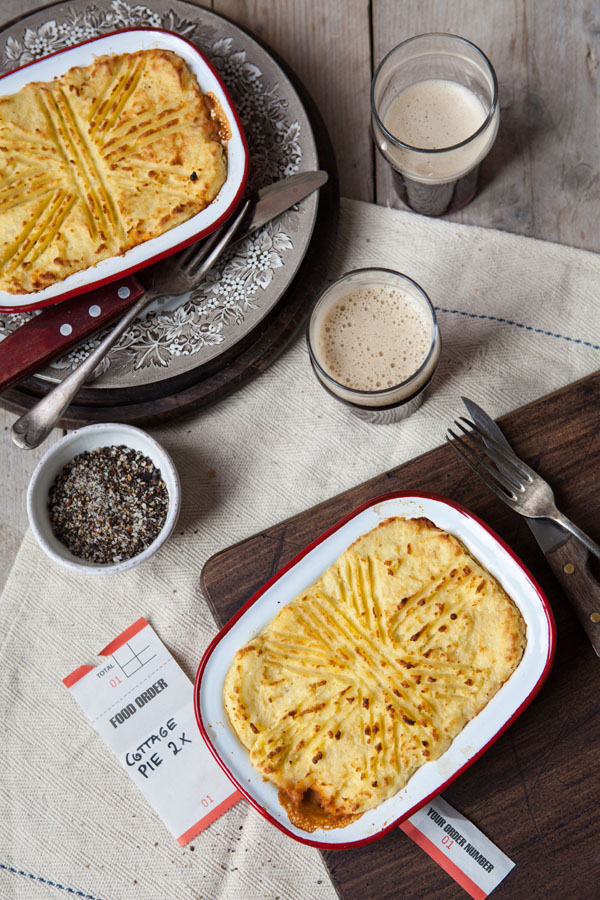
Wishing you all a happy Saint George’s Day with these humble cottage pies. I’ve been mostly working on my book, stuck with my nose in research and absolutely loving it but in the evening I long for great simple food with pure flavours. This pie is just that, with the best spuds you can find for your mash, decent flavoursome beef and a layer of moist spinach, this is a treat for me. I just wrap it in a towel and relax with a beer and a movie.
No doubt you will all have been waiting for the dragon slaying moment in this story but unfortunately I will have to disappoint you as there are no dragons in this tale.
Then the tale of George and the dragon appears in the Legenda sanctorum or Golden legend, a collection of hagiographies (stories of the Saints) by Jacobus de Voragine. This book of which there were over a thousand of manuscripts in the 13th century was very popular and was one of the first books that were printed in the English language when printing was invented around 1450.
So what are you up to today?
- 400 g beef mince, from chuck steak
- 1 large chestnut mushroom or a white one
- 1 stalk of celery
- 1 small carrot
- 1 clove of garlic
- a knob of butter to fry the meat and veg
- 1 small tin of tomato puree 50-70 gr (concentrate of tomato)
- 1 glass of red wine or stout beer like guinness – 250 ml
- 2 teaspoons of Worcester sauce
- 300 ml of beef or vegetable stock (I use an organic vegetable stock cube)
- Salt and pepper to taste
- A few handfuls of fresh spinach (you can use from your freezer too)
- Potato mash, you need 4 large spuds or use leftover if you have some
- Add 4 teaspoons of grated cheddar cheese
- 2 individual trays, or one larger one. Small pie pans work well. (14×19)
Method
Cook your spuds and make your mash with milk, butter, nutmeg and salt. If you like to make it richer, add an egg yolk too. You need a silky smooth mash which is slightly wetter than you’d eat it normally as it dries a bit in the oven.
Chop all the vegetables and add to a heavy based casserole, glaze a little over a medium flame and then add the meat. Brown the meat and add the tomato puree, stir well to combine evenly
When the tomato starts to caramelise – which means stick to the bottom of the pan, pour in the wine or beer. Stir to loosen up the meat and veg.
Let the booze evaporate, it takes about a minute, and it will be reduced a lot. If you don’t want to use alcohol, use water or stock
Now pour in the garlic, stock, and the Worcester sauce and put on the lid, leave for 30 minutes but check on it frequently so it doesn’t burn to the base. You may leave it longer too, it is merely for the flavours to develop.
Use boiling water from the kettle and blanch your spinach, drain and add a cube of butter, you may omit this but butter does taste so very well.
Preheat your oven to 180°C
Place your spinach in your chosen baking tray or trays, season with pepper.
When the meat is ready, transfer it to you tray or trays.
Now make the mash layer by scooping blobs of potato on the meat, then spread out.
You can pipe this mash, but who has the time to pipe mash on a weekday??
Place into the oven under the gril for about 10-15 minutes or until your mash has some color. It depends really on what you like, lightly coloured or not.
Serve with a beer, or wine if you like.
Put the rest in the freezer, we usually have some leftovers. These pies freeze very well, just defrost in your fridge overnight when planning to use.
Enjoy
You might also enjoy
Beef and Oyster pie
Watercress and trout pie
Sussex Stewed steak
Thank you for leaving a comment!
The post George, the Dragon and the Cottage pie appeared first on Miss Foodwise.
]]>